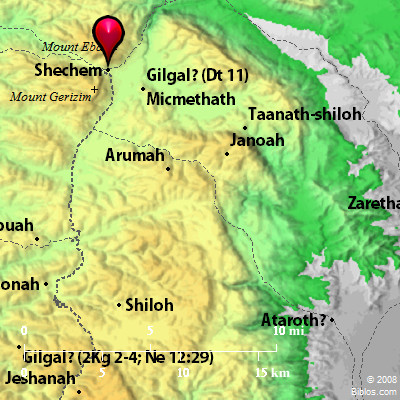Atlas  Moreh (Shechem) and surrounding area Maps Created using Biblemapper 3.0 Additional data from OpenBible.info Occurrences Genesis 12:6 Abram passed through the land to the place of Shechem, to the oak of Moreh. The Canaanite was then in the land.Deuteronomy 11:30 Aren't they beyond the Jordan, behind the way of the going down of the sun, in the land of the Canaanites who dwell in the Arabah, over against Gilgal, beside the oaks of Moreh? Encyclopedia MOREH, HILL OFmo'-re (gibh`ath ha-moreh, "hill of the teacher"; Codex Vaticanus Gabaathamora; Codex Alexandrinus, tou bomou tou Abor): The Hebrew moreh is derived from the verb yarah, "to teach," "to direct," and indicates one who directs, or gives oracular answers. We might therefore read "hill of the teacher," the height being associated with such a person who had his seat here. The hill is named only in describing the position of the Midianites before Gideon's attack (Judges 7:1). If the identification of the Well of Harod with `Ain Jalud is correct, Gideon must have occupied the slopes to the East of Jezreel. The Midianite camp was in the valley of Jezreel (Judges 6:33). The Hebrew text in Judges 7:1, which has probably suffered some corruption, seems to mean that the Midianites lay North of the position held by Gideon, their lines running from the hill of Moreh in the plain. The hill can hardly have been other than Jebel ed-Duchy, often called Little Hermon, which rises boldly from the northern edge of the vale of Jezreel, with Shunem (Solam) lying at its western foot. Moore ("Judges," ICC, 200) would lay the scene in the neighborhood of Shechem, but there is no good reason to doubt the accuracy of the tradition which places it at the eastern end of the plain of Esdraelon. MOREH, OAK OF ('elon moreh, "terebinth of the teacher"; ten drun ten hupselen; the King James Version Plain of Moreh): It seems probable that the place here intended may be the same as that mentioned in Deuteronomy 11:30 ('elone moreh, "terebinths of Moreh," the King James Version "plains," the Revised Version (British and American) "oaks," the Revised Version margin "terebinths"). Both are defined as near to Shechem. The position cannot be identified today. The tree or trees were evidently a place of resort for those who wished to consult a moreh. See MOREH, HILL OF. To this day in Palestine trees are often regarded with a certain religious awe as the habitation of spirits. Isolated terebinths receive much veneration. The present writer has often seen such trees with multitudinous rags of all colors attached to them by the peasantry as evidence of their homage. MO'REH, a hill, now Jebel ed Duhy, also called "Little Hermon," but never in Scripture. It is an irregular ridge, 12 ms. long, its highest point is 1690 ft. above the Mediterranean, and there is at this point a tomb from which the hill takes its modern name. On the s. was Gilboa and on the n., Mt. Tabor. It is 57 ms. n. from Jerusalem and runs from n.w. to s.e. the n. w. end being the highest. Strong's Hebrew H4176: Moreha place near Shechem, also a hill of unc. location |



